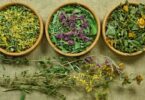Here are the easiest methods for drying stinging nettle at home!
Since ancient times, stinging nettle (scientific name Urtica dioica) has been a fixture in herbal medicine. Roman troops rubbed the herb on themselves to keep them warm, while ancient Egyptians used it to treat lower back pain and arthritis.
Stinging nettle leaves come with hair-like structures that sting and produce redness, itching, and swelling. But, once dried, processed into supplement form, cooked, or freeze-dried, it can be consumed safely. Here are the easiest methods for drying stinging nettle leaves at home.
How to Dry Stinging Nettle
The following are the different methods for drying stinging nettle to allow you to preserve the benefits of the herb for a longer period of time.
Drying stinging nettle in a food dehydrator
- Put a pair of gloves on. Dip and swish the stinging nettles in a bowl filled with cold water. Repeat the process in a bowl of fresh water. Drain well.
- Pat them dry. This is because droplets of water can lead to mold or cause dark spots. To prevent spoiling, remove the surface moisture by patting and rolling the stinging nettles in a clean towel.
- Spread the leaves and stems on the dehydrator’s drying trays. Set the dehydrator to the lowest temperature setting or around 95F.
Allow drying for about 12 to 18 hours. It will take a longer time to dry the stems compared to the leaves, so make sure to test the stems to find out if the drying process is done. If preferred, you can instead dry the stems and the leaves separately.
Hang drying the stinging nettles
- Repeat steps 1 and 2 of drying using a food dehydrator.
- Gather 5 to 6 stems. Tie them together using ordinary kitchen string. Make sure to provide for proper air circulation by not tying a lot of stems together.
- Label the bundles. Hang them in a dry, clean, and dark place. Some people do it on their dining room light fixture.
Allow the nettles to dry for 1 to 3 weeks, depending on the bundle size, humidity, and nettle maturity.
Drying stinging nettle in an oven
- Repeat steps 1 and 2 of drying using a food dehydrator.
- Set the oven to the lowest temperature setting. Lay down the herbs on a tray or grill. Close the oven door, but make sure to put something on the door a piece of stick to make the door stay open a bit. Some heat must escape; otherwise, you might cook the herbs when all you want is to dry them.
Allow drying for 3 to 4 hours, checking frequently for dryness.
Using a microwave oven
- Repeat steps 1 and 2 of drying using a food dehydrator.
- Layer the stinging nettles in paper towels in the microwave.
- Process for 1 to 3 minutes. Test as you go. Note that there is always the danger of cooking the herbs when using this method.
How to Properly Store Dried Stinging Nettle
Following are the steps to store dried stinging nettles to preserve their shelf life:
- Make sure to keep the stems and leaves in big pieces. This will help retain as much essential oils and flavor as possible.
- Store the pieces in glass jars or paper bags. Plastic bags are not recommended as they may cause condensation.
- Leave the containers in a dry, cool, and dark place where there is consistent temperature.
Your dried stinging nettles will be good and safe for use within 6 to 12 months. While the herb may last longer than that, the nutritional properties and quality may start to deteriorate.
READ ALSO: A Complete Guide on How to Store Dried Herbs
How to Use Dried Stinging Nettle
You can use dried nettle to make herbal tea blends. You can use it with rose hips, anise hyssop, cinnamon, and Chaga. You can also mix stinging nettle with lemon balm, mint or other available herbs in your home.
You can likewise add stinging nettle to stews, casseroles, or soups. It is also a great healthy addition to backcountry dehydrated meals. Bear in mind that once dried, stinging nettle is perfectly safe for use.
You can also turn dried nettle into powdered form. You can then use the powder for pasta, baking, and smoothies.
Benefits of Dried Stinging Nettle
The following are the benefits of using stinging nettle.
1. Stinging nettle has lots of nutrients
The plant contains various minerals, vitamins, amino acids, fatty acids, pigments, and polyphenols, with a lot of them acting as antioxidants inside the body.
2. Dried stinging nettle may lower inflammation
Stinging nettle helps subdue inflammation. This, in turn, can help relieve inflammatory conditions including arthritis, though more studies are needed to conclusively prove the claim.
3. It may help in the treatment of enlarged prostate symptoms
The herb may be of help in reducing the size of the prostate, as well as treat enlarged prostate gland symptoms in men suffering from BPH.
4. It may help treat hay fever
Stinging nettle is believed to reduce the symptoms of hay fever. However, some studies tend to indicate that it is nothing more than just placebo effect. Thus, more research is needed to prove stinging nettle’s efficacy on hay fever.
5. Dried stinging nettle may help lower blood pressure
The plant is believed to aid in lowering blood pressure by letting the blood vessels relax and limiting the force of the contractions of the heart. But, more studies on humans need to be made to confirm these claims.
6. Stinging nettle may help control blood sugar levels
Although stinging nettle can potentially lower your blood sugar levels, more studies on humans are necessary to prove this effect.
Stinging nettle is known to offer a lot of nutrients. It is popular in herbal medicine. According to numerous studies, the herb may help reduce inflammation, blood sugar levels, blood pressure, and hay fever symptoms.
Although stinging nettle can cause irritation when fresh, it is safe to consume when dehydrated, cooked, or freeze-dried.





